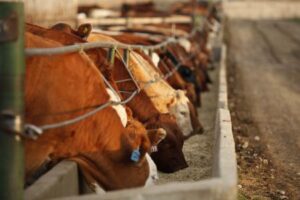Yo-Yo Diet Strategies
Remarque : cette page web n’est actuellement disponible qu’en anglais.
This article written by Dr. Reynold Bergen, BCRC Science Director, originally appeared in the October 23, 2017 issue of Canadian Cattlemen magazine and is reprinted on the BCRC Blog with permission of the publisher.

Getting weaned calves on feed can be a challenge. This is often attributed to the change from a forage-based diet to unfamiliar feedlot rations and feed bunks, distress from recent weaning, illness, etc. To compensate for this, some feeders use a relatively high-energy receiving diet, the rationale being that if they’re not going to eat much, each mouthful better pack a nutritional punch. But part of the challenge these calves face may be complications from feed deprivation during marketing and transportation. Recent research led by the University of Saskatchewan’s Greg Penner suggests that the rations fed both before and after feed restriction affect how well cattle cope with and recover from these challenges (J. Anim. Sci. 91:4730-4738 and 91:4739-4749).
What they did
This study used 20 spayed, ruminally cannulated, individually-penned heifers averaging 1,050 pounds. These obviously weren’t freshly weaned calves, but using older animals allowed the researchers to avoid confusing the effects of feed restriction with the effects of weaning stress, disease challenge, new diets, etc. Ten heifers were fed a high-forage (92 per cent) diet and 10 were fed a moderate-forage (60 per cent) diet for two weeks. For the next five days their intake was restricted to 25 per cent of what they had been eating. Then they were allowed to resume eating as much as they wanted for three weeks. During this recovery period, half of the high-forage heifers were switched to the moderate-forage diet, and vice versa.
Rumen microbes digest the animal’s feed and produce short-chain fatty acids. These short-chain fatty acids influence rumen pH, and are absorbed through the rumen wall into the bloodstream, where they provide up to 75 per cent of the animal’s energy needs. Some short-chain fatty acids also stimulate cells in the rumen wall to grow, divide, and function properly. Because of their important roles in digestive health, the researchers collected very detailed rumen pH and fatty acid measurements
throughout the study. They also measured non-esterified fatty acids in the bloodstream. These are fatty acids that have been released due to fat breakdown in the body in response to an energy shortage.
What they learned
Average rumen pH didn’t differ between the two diets during the initial two-week prerestriction period. Rumen pH increased in both groups of heifers during the feed restriction period, partly because there was less feed for the rumen microbes to digest. The rate of short-chain fatty acid absorption also dropped by nearly 20 per cent in both groups during the feed restriction period, but specialized techniques
were used to confirm that slower absorption wasn’t just caused by less food fermenting in the rumen. Non-esterified fatty acid levels in the bloodstream rose in both groups of heifers during feed restriction, but more in the high-forage group than in the moderate-forage group. This suggests that the forage-fed heifers were burning more body fat to meet their own energy needs during the feed restriction.
The effects of the pre-restriction and post-restriction diets on intake and rumen function during the three week recovery period were compared.
Pre-restriction diet
The heifers that had started the experiment on the high-forage diet took longer to increase their feed intake to the expected level than those that had been on the moderate-forage diet. The heifers that had started on the high-forage diet also spent over three hours per day at a pH below 5.5 during the first week of the recovery period, nearly twice as long as those that had started on the moderate-forage diet. Short-chain fatty acid absorption rates during the recovery period were the same regardless of which diet the heifers were on before restriction.
Post-restriction diet
Unlike the pre-restriction diet, heifers fed the moderate-forage diet increased their feed intake more slowly than heifers fed a high-forage diet during the recovery period. Heifers fed the moderate-forage diet during the recovery period also spent over 4.5 hours per day at a rumen pH below 5.5, compared to less than 15 minutes for heifers fed the high-forage diet during the recovery period. Short-chain fatty acid absorption rates during the recovery period were the same regardless of which diet the heifers were on after restriction.
What it means
Assessing the real production, health and economic effects of these diets would require a larger study using weaned calves moving from the farm to the
feedlot. But the results of this experiment suggest that calves adapted to a moderate-forage diet before leaving the farm may be better equipped to cope with feed restrictions imposed by marketing and transportation than calves weaned straight off grass, regardless of the receiving diet at the feedlot. It also suggests that regardless
of the pre-arrival diet, calves fed a high-forage diet may recover more quickly from feed restriction than calves fed a moderate-forage receiving diet, regardless of what they were eating before they arrived.
Click here to subscribe to the BCRC Blog and receive email notifications when new content is posted.
The sharing or reprinting of BCRC Blog articles is typically welcome and encouraged, however this article requires permission of the original publisher.
We welcome your questions, comments and suggestions. Contact us directly or generate public discussion by posting your thoughts below.